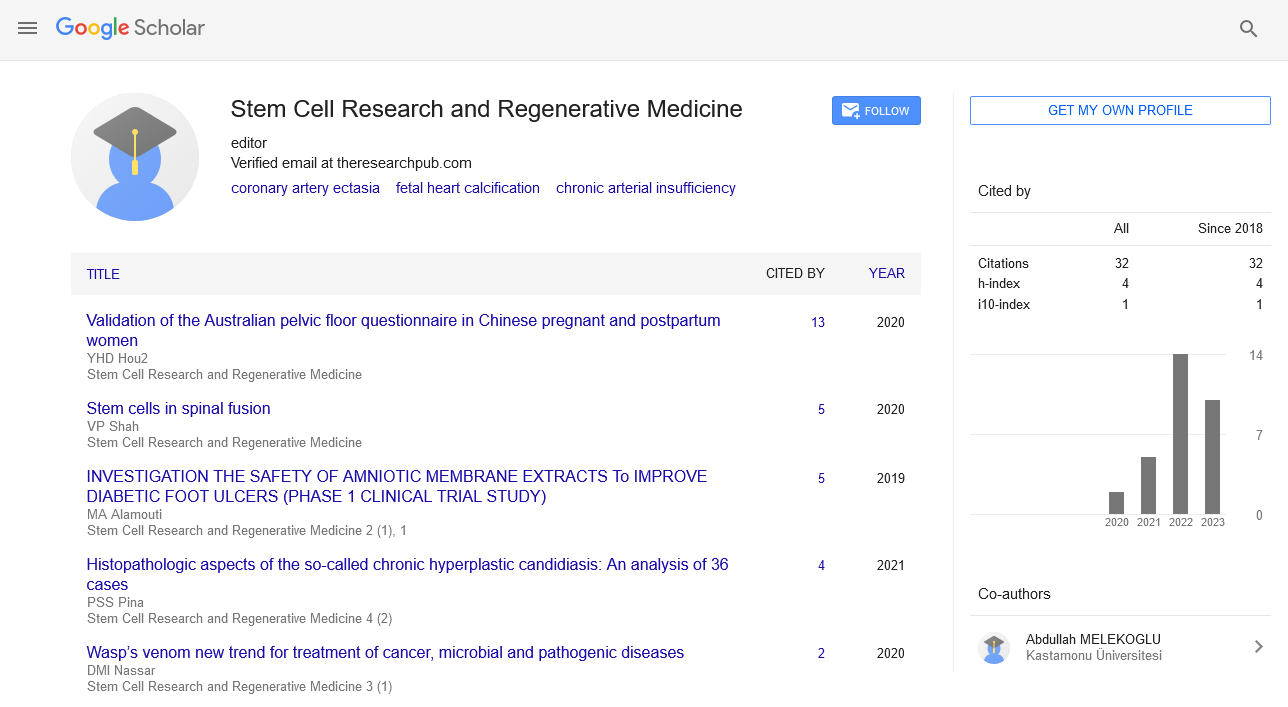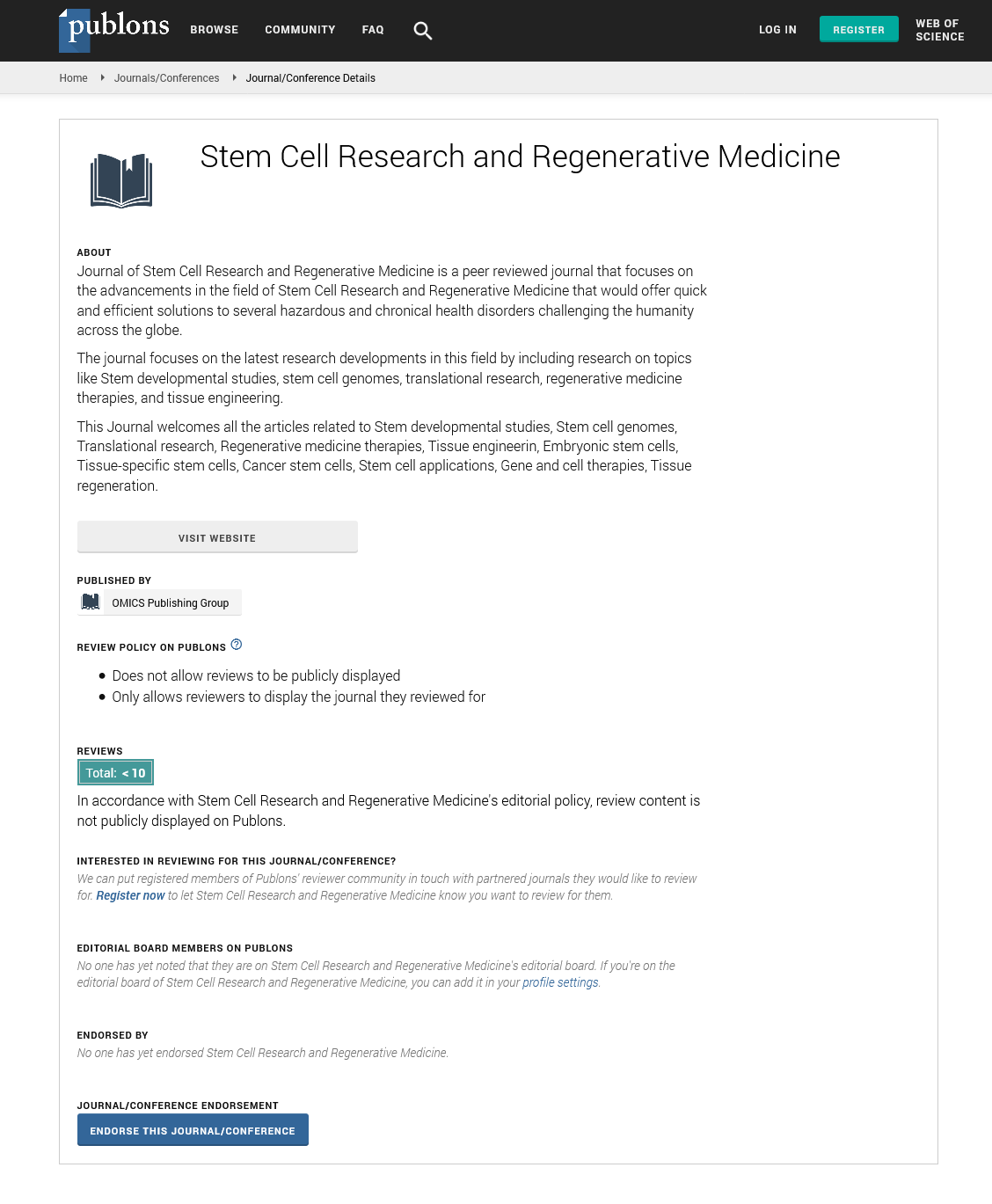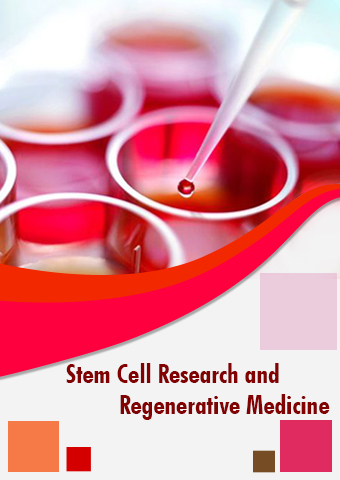Perspective - Stem Cell Research and Regenerative Medicine (2024) Volume 7, Issue 6
Stem Cell Dysfunction in Aging: Barriers and the Potential for Rejuvenation Therapies
- Corresponding Author:
- Aldine Richard
Department of Clinical Pathology, Cairo University, Cairo, Egypt
E-mail: Absco49@gmail.com
Received: 02-Dec-2024, Manuscript No. SRRM-24-153873; Editor assigned: 04-Dec-2024, Pre QC No. SRRM-24-153873 (PQ); Reviewed: 16-Dec-2024, QC No. SRRM-24-153873; Revised: 23-Dec-2024, Manuscript No. SRRM-24-153873 (R); Published: 31-Dec-2024, DOI: 10.37532/SRRM.2024.7(6).293-294
Introduction
The decline in stem cell function is a hallmark of aging, impacting tissue regeneration, immune response, and overall health. Stem cells, which are responsible for maintaining and repairing tissues throughout life, gradually lose their regenerative potential as we age. This decline contributes to the deterioration of organ function, increased susceptibility to diseases, and a slower healing response. Understanding the mechanisms behind age-related changes in stem cell behavior and developing strategies to rejuvenate them is a rapidly advancing field that holds the promise of mitigating some of the effects of aging and improving the quality of life in older adults.
Description
Immune rejection occurs when a patient’s immune system recognizes transplanted cells as foreign and mounts an immune response to attack and destroy them. This is particularly common in allogeneic cell therapies, where cells from a donor are introduced into a patient’s body. The immune system is highly efficient at detecting foreign cells, and even slight differences between donor and recipient cells can trigger a robust immune response. Immune rejection can lead to the loss of therapeutic cells, reducing the efficacy of treatment and requiring repeated interventions. Strategies to mitigate immune rejection are crucial to improving the success rates of cell therapies and reducing the need for long-term immunosuppression, which carries its own risks and complications.
One promising approach to minimize immune rejection is the use of autologous cell therapies, where a patient’s own cells are harvested, modified, and reintroduced. Because the cells are genetically identical to the patient, the risk of immune rejection is significantly reduced. Autologous therapies have shown success in a range of applications, from hematopoietic stem cell transplants to CAR-T cell therapies for cancer. However, the autologous approach is not without challenges. The process of harvesting and expanding the patient’s cells can be time-consuming, expensive, and logistically complex, limiting its accessibility. Additionally, for patients with genetic disorders, using their own cells may not be ideal, as the underlying genetic defects could compromise the therapeutic potential of the cells.
To address these limitations, researchers are exploring innovative methods to create “universal” or “off-the-shelf ” cell therapies that are less likely to provoke immune rejection. One strategy involves gene-editing technologies, such as CRISPR-Cas9, to modify donor cells and reduce their immunogenicity. By knocking out specific genes that are responsible for immune recognition, it may be possible to create cells that are less likely to be attacked by the patient’s immune system. Another approach is to engineer cells with immunomodulatory properties, enabling them to evade immune surveillance or suppress local immune responses. These modifications could make allogeneic cell therapies safer and more widely available, providing an alternative to the logistical challenges of autologous treatments.
In addition to modifying the therapeutic cells themselves, targeting the patient’s immune system is a key strategy to prevent immune rejection. Immunosuppressive drugs are commonly used to dampen the immune response during and after cell therapy, but they come with significant drawbacks, including an increased risk of infections and other complications. Researchers are exploring more targeted and temporary immunosuppressive strategies that minimize side effects while protecting therapeutic cells. For example, monoclonal antibodies that specifically block key immune pathways involved in rejection, such as those targeting T-cell activation or cytokine signaling, are being developed. These targeted approaches aim to create a more favorable immune environment for the transplanted cells, allowing them to engraft and function effectively without compromising the patient’s overall immune function.
Another major immune challenge in cell therapies is Graft-Versus-Host Disease (GVHD), which occurs when donor immune cells attack the recipient’s tissues. GVHD is a particular concern in hematopoietic stem cell transplants, where donor immune cells are introduced into the patient’s body. While donor immune cells are critical for fighting infections and cancers, they can also cause severe damage to the patient’s tissues if they are not properly controlled. Addressing GVHD requires a delicate balance between suppressing harmful immune responses while preserving the beneficial effects of donor immune cells. One approach is the selective depletion of alloreactive T cells the immune cells most likely to cause GVHD before transplantation. Techniques such as ex vivo T-cell depletion or the use of immune-magnetic beads can remove alloreactive cells while retaining those that contribute to the therapeutic effect.
In recent years, regulatory T cells (Tregs) have gained attention as a potential tool for managing GVHD and preventing immune rejection. Tregs are a specialized subset of immune cells that play a crucial role in maintaining immune tolerance and preventing autoimmune reactions. By expanding and infusing Tregs along with therapeutic cells, it may be possible to create a more tolerant immune environment and reduce the risk of GVHD. Clinical trials investigating Treg therapy in the context of hematopoietic stem cell transplants have shown promising results, suggesting that Tregs could become a valuable addition to cell therapy protocols. Combining Treg therapy with other immunomodulatory strategies, such as cytokine inhibitors or adoptive cell transfer, may further enhance its efficacy and safety.
Advanced biomaterials are also being explored as a means of mitigating immune rejection and GVHD in cell therapies. Encapsulation techniques, where therapeutic cells are enclosed in biocompatible materials, can provide a physical barrier that protects cells from immune attack. These materials can be engineered to allow the exchange of nutrients and therapeutic molecules while preventing direct contact between the transplanted cells and the patient’s immune system. Encapsulation has shown promise in the treatment of conditions like type 1 diabetes, where encapsulated pancreatic cells can produce insulin without being targeted by the immune system. The use of advanced biomaterials may extend to other cell-based therapies, offering a versatile solution to immune-related challenges.
Despite the progress in overcoming immune rejection and GVHD, there are still many obstacles to address before cell therapies can achieve widespread acceptance. The complexity of the immune system and the variability between individuals make it challenging to develop a one-size-fits-all solution. Tailoring immune-modulating strategies to each patient’s unique immune profile may be necessary for optimal outcomes. Additionally, the long-term effects of immune modulation, gene editing, and biomaterial encapsulation are not yet fully understood, requiring careful evaluation in clinical trials. Ethical considerations related to gene editing, cell source, and the balance between safety and efficacy must also be taken into account to ensure responsible and equitable development of cell therapies.
Conclusion
Addressing immune rejection and graft-versushost disease is a critical step in realizing the full potential of cell-based therapies. By employing a combination of autologous approaches, gene editing, targeted immunosuppression, Treg therapy, and advanced biomaterials, researchers are making significant strides toward safer and more effective treatments. These innovations not only promise to improve the outcomes of existing cell therapies but also open the door to new applications in regenerative medicine, cancer treatment, and beyond. As the field continues to evolve, the goal of providing safe, effective, and accessible cell-based therapies for a wide range of conditions is becoming more achievable, bringing hope to patients and advancing the frontier of modern medicine.


